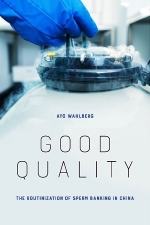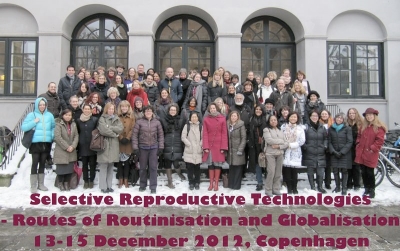Selective Reproductive Technologies

PROJECT IS COMPLETED
Project period: 2011-2014
Selective Reproductive Technologies was a three year research project originally named ‘Exchanging ‘good’ life – socio-technical imaginaries in a Chinese sperm bank'.
The project consisted of the following components:
- An in-depth ethnographic study of a Chinese sperm bank led by Ayo Wahlberg.
- An international conference on the social and ethical challenges of sperm banking (Changsha, May 2012) organised in collaboration with the CITIC-Xiangya Reproductive and Genetic Hospital in China.
- An international conference on Selective Reproductive Technologies (Copenhagen, December 2012) organised in collaboration with the Centre for Medical Science and Technology Studies.
- A Sino-Danish researcher exchange programme which allowed Chinese doctoral and postdoctoral researchers to travel to Denmark to study ethical governance of reproductive technologies in Denmark and Europe.
Further to enabling an ethnographic study of sperm banking practices in China entitled ‘Exchanging ‘good’ life’, the project aimed to invigorate the momentum surrounding social studies of selective reproductive technologies (SRTs) around the world through two international conferences and a researcher exchange programme between China and Denmark.
Over the recent decades, social scientists have followed assisted reproductive technologies (ARTs) on routes of routinisation and globalisation, examining their development by clinicians and scientists as well as their impact on the daily lives of involuntarily childless couples in different cultural and socio-economic contexts. Recently, similar attention has been directed at what Ayo Wahlberg and Tine Gammeltoft came to term selective reproductive technologies as these continue to be routinised and globalised as clinical-laboratory practices.
Although they often rely on similar techniques, it is important to distinguish between the two forms of reproductive technology: While ARTs aim to overcome biological obstacles to ‘natural’ reproduction, SRTs aim to prevent or allow the birth of certain ‘kinds of children’.
Selective reproductive technologies:
- Comprise of specific laboratory and clinical techniques, which facilitate the selective fertilisation of gametes, implantation of embryos or abortion of foetuses.
- Encompass practices of e.g. counselling, carrier testing, gamete donor screening, gamete and embryo quality assessment/biopsy, ultrasonography, blood chemistry analysis, amniocentesis, chorionic villus sampling, karyotyping, genetic testing and/or induced abortion.
- Generate deliberations and negotiations about whether (and if so how) to begin, terminate or continue a pregnancy.
- Are used by individuals and governments to prevent or promote the birth of certain ‘kinds of children’ (e.g. a child suffering from ‘serious disease’, a healthy child, an intelligent child, a male child, a saviour sibling).
Based at the Department of Anthropology, University of Copenhagen, the project was led by then postdoctoral research fellow, now Professor MSO Ayo Wahlberg.
International conferences were held in collaboration with the CITIC-Xiangya Reproductive and Genetic Hospital, China, and the Centre for Medical Science and Technology Studies, UCPH.
Books

- Wahlberg, A. 2018. Good Quality - the Routinization of Sperm Banking in China, Berkley: University of California Press [winner of the 2019 Council on Anthropology and Reproduction Book Prize, Society for Medical Anthropology, American Anthropological Association], Listen to an interview with Ayo Wahlberg here.
- Wahlberg, A. & Gammeltoft, T. 2017. Selective Reproduction in the 21st Century, London: Palgrave Macmillan
Special journal issue
- Villadsen, K. & Wahlberg A. (2015) guest editors, special feature on “The government of life: managing populations, health and scarcity”, Economy and Society 44(1)
Journal articles
- Wahlberg, A. 2018. ‘Exposed Biologies - and the Banking of Reproductive Vitality in China’, Science, Technology & Society, 23(2): 307-23
- Wahlberg, A. 2018. ‘Banking on the Future: Everything you always wanted to know about sperm donation in China’. World Policy Journal, 35(1), 91-98.
- Wahlberg, A. 2016. 'The birth and routinization of IVF in China', Reproductive Biomedicine & Society Online, 2: 97-107
- Wahlberg, A. & Rose, N. 2015. 'The governmentalization of living: Calculating global health'. Economy and Society, 44(1): 60-90
- Gammeltoft, T. & Wahlberg, A. 2014.'Selective Reproductive Technologies'. Annual Review of Anthropology 43: 201-216
Book chapters
- Wahlberg, A. 2014. Human Activity between Nature and Society: The Negotiation of Infertility in China in K Hastrup (ed.), Anthropology and Nature. Routledge: London, pp. 184-195.
- Wahlberg, A. 2010. 'Assessing vitality: Infertility and good life in Urban China'. In J Yorke (ed.), The Right to Life and the Value of Life: Orientations in Law, Politics and Ethics. Farnham: Ashgate Publishing Ltd, pp. 371-397.
Selective reproductive technologies – routes of routinisation and globalisation
International Conference, 13–15 December 2012, University of Copenhagen, Denmark

In December 2012, nearly one hundred scholars convened in Copenhagen, Denmark. With more than fifty presentations with empirical contributions from over twenty countries, the conference aimed at invigorating the momentum that has been gathering around social studies of selective reproduction in the 21st century.
The conference was organised by the Department of Anthropology in collaboration with the Centre for Medical Science and Technology Studies, UCPH.
Focussing on comparative social science research into the routinisation and globalisation of selective reproductive technologies (SRTs), the conference discussed key questions like:
- How have selective reproductive technologies been taken up and put into practice in different cultural and socio-economic contexts?
- In which ways are prospective parents in different countries engaging with these technologies?
- How do SRT providers interact and communicate with prospective parents?
- What visions and imaginings of potentiality guide clinical practice in the realm of reproductive selection?
- What are some of the structural constraints/possibilities that these technologies come to be embedded in?
- What are the roles of government authorities in promoting or regulating the use of SRTs?
- How do market forces and other economic factors fuel or constrain the routinisation of SRTs?
- Finally, the conference explored how routinisation and globalisation took place: When and how were these technologies introduced in various countries, what forms of opposition did they encounter, which role did public criticism play for the practical, technological and regulatory development of the technologies in question?
The keynote speakers were:
- Sarah Franklin, Department of Sociology, University of Cambridge
- Lene Koch, Centre for Medical Science and Technology Studies, University of Copenhagen
- Rayna Rapp, Department of Anthropology, New York University
The Danish newspaper Kristeligt Dagblad wrote about the conference (article no longer available).
The social and ethical challenges of sperm banking
International conference, Changsha, 5 May 2012.
In May 2012, an international conference was held in Changsha, China, with the aim of exchanging ideas and research between China and Denmark on the social and ethical challenges of sperm banking.
The conference brought together an interdisciplinary group of speakers and attendees from China and Europe including clinicians, nurses, life scientists, administrators, social scientists, ethicists and lawyers.
Among the key issues were:
- Recruitment – altruism and compensation
- Donor anonymity
- Donor screening
- Consanguinity
- AID counselling – secrecy and confidentiality
- Qualified recipients
- Reproductive Insurance
- Posthumous retrieval and use of sperm
The conference was organised by The Department of Anthropology, University of Copenhagen & the CITIC-Xiangya Reproductive and Genetic Hospital, Changsha.
The Government of Life
International symposium, Copenhagen, 8-10 April 2013.
In April 2013, a symposium was held in Copenhagen to examine how innovative conceptual work that had taken place around both bio-power and gouvernementalité could be brought further into interlocution in contemporary empirical scholarship through a prism of ‘the government of life’.
Key questions included:
- How might life be empirically studied as a problematic of government?
- How do particular forms of government generate specific understandings and valuations of ‘life’?
- In which ways can we further conceptualise (emergent) relations between normative valuations, knowledge of life/knowledge of living and the government of life/living?
- What different vital characteristics of human existence are at stake in the government of life?
- Which authorities and forms of expertise make claims/are accorded the capacity to speak truthfully about human life?
The Population Quality Problem in East Asia
A panel at the International conference 'Growth: Critical Perspectives from Asia', 13-14 June 2013, University of Copenhagen
Panel conveners: Susan Greenhalgh (Harvard University), Tine Gammeltoft (University of Copenhagen), Masae Kato (University of Amsterdam) & Ayo Wahlberg (University of Copenhagen).
The panel aimed to trace and examine the different ways in which concerns about population quality have played out in East Asian countries.
Articles and interviews in media
(All in Danish)
5 September 2013: Videnskab.dk
Enebørn skal sikre Kinas globale succes
6 September 2013: Jyllands-Posten
Kineserne vil have hjælp til at få børn
6. September 2013: P1, national radio
Kineserne øger befolkningskvaliteten - interview (no link)
8 September 2013: Jyllands-Posten
Enebørn sikrer Kinas fremtidige succes
October 2013: Radio 24/7
'Globus Kina' - interview (no link)
2013: Weekendavisen
Rapport fra den globale babyfabrik (no link)
Own article on the project
Anthropologist helps mark the 30th anniversary of China’s first ‘test-tube’ babies
Ayo Wahlberg
Professor MSO
E-mail: ayo.wahlberg@anthro.ku.dk
Telephone: +45 35 32 44 51
The project was funded by:
Selective Reproductive Technologies was funded by the Sapere Aude Young Researcher programme of the Danish Council for Independent Research.
Project: Selective Reproductive Technologies
Principal investigator: Ayo Wahlberg
Start: 2011
End: 2014

